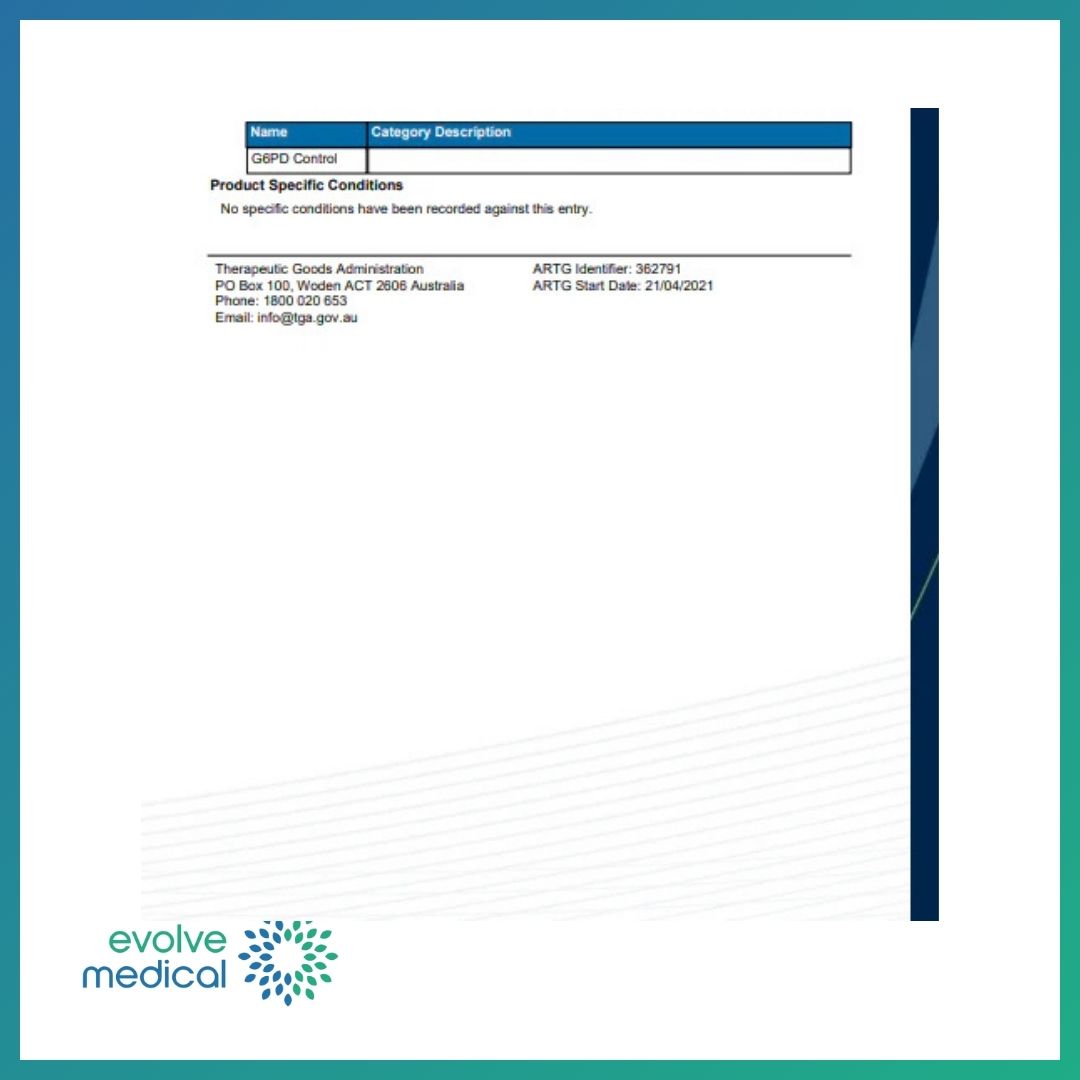Evolve Medical Solutions
G6PD Starter Kit (Analyser, Strips, Controller)
G6PD Starter Kit (Analyser, Strips, Controller)
Couldn't load pickup availability
Called the STANDARD G6PD
Quantitative measurement of G6PD enzyme activity in just 2 minutes from human whole blood specimen.
The STANDARD G6PD Analyzer is designed to measure the quantitative determination of total-hemoglobin concentration and G6PD enzymatic activity in fresh human whole blood specimen based on reflectometry assays. The test is intended to aid in the identification of people with G6PD deficiency providing point-of care access and allowing prompt treatment decisions. The analyzer is for in vitro diagnostic use and professional use only. The analyzer should be used exclusively with the STANDARD G6PD test device and STANDARD G6PD check strip manufactured by SD BIOSENSOR.
G6PD start-up kit. Includes the analyser machine, the controller and 1 x 25pk of test strips.
EXPLANATION AND SUMMARY
Introduction
G6PD (glucose-6-phosphate dehydrogenase) deficiency is one of the most common enzymopathological diseases, described as a widespread, heritable, X-chromosome linked abnormality. It is estimated that it affects approximately 400 million people worldwide and the prevalence can be as high as 25 percent in ethnic populations originating from Africa, the Middle East, Asia, and the Mediterranean.[1,2] The G6PD enzyme plays an important role in survival of erythrocytes. The G6PD enzyme is involved in the PPP (pentose phosphate pathway) and provides the NADPH (reduced nicotinamide adenine dinucleotide phosphate) and GSH (reduced glutathione). GSH produced by PPP can react with H202 and reduce H202 to H20. This helps protect erythrocytes from certain generation of oxidative stress.[3,4] The most common medical problem associated with G6PD deficiency is hemolytic anemia, which can lead to paleness, yellowing of the skin and whites of the eyes, dark urine, fatigue, shortness of breath, and a rapid heart rate. The STANDARD G6PD Test is a fast, simple and reliable test system that provides results in 2 minutes and point-of-care diagnosis of G6PD deficiency.
Intended use
The STANDARD G6PD System is an enzymatic colorimetric assay intended for the semi-quantitative measurement of G6PD activity and total hemoglobin (T-Hb) concentration in non-anticoagulated capillary (finger-stick) whole blood or venous whole blood (K2-EDTA, sodium heparin, or acid citrate dextrose [ACD]). The STANDARD G6PD Test System is indicated for diff erentiating normal, intermediate, and defi cient G6PD activity levels to aid in the detection of G6PD defi ciency in individuals and in the determination of hemoglobin level. The test will provide results expressed as the ratio of units of G6PD activity per gram of hemoglobin (G6PD U/g Hb) which can be used to determine G6PD status. Samples which generate a G6PD defi cient or intermediate result should be assayed using a quantitative G6PD test to verify a defi ciency. T-Hb results expressed in grams per deciliter (g/dL) are used to determine G6PD status and not state of anemia. T-Hb results should be confirmed by a quantitative test when monitoring disease progression or making treatment decisions. The STANDARD G6PD Test System is intended for use by health care professionals in a laboratory or point-of-care environment. The system is for in vitro diagnostic use only. The STANDARD G6PD Test has not been validated for use with neonatal samples. The STANDARD G6PD Analyzer must be used exclusively with the STANDARD G6PD Test Device, STANDARD G6PD Control, and STANDARD G6PD Check strip manufactured by SD BIOSENSOR.
Test Principle
The STANDARD G6PD Test contains a flow through STANDARD G6PD Test Device with treated membrane and mesh. The test is based on a colorimetric detection system for the automatic calculation of G6PD activity on the code-chip for each test device. G6PD catalyzes the first step in the PPP, oxidizing G6P (glucose-6-phosphate) to 6-phosphogluconolactone and reducing NADP (nicotinamide adenine dinucleotide phosphate) to NADPH. When NADPH is generated by G6PD, the BCIP (5-bromo-4-chloro-3-indolyl-phosphate) and NBT (nitro blue tetrazolium) are reduced by the diaphorase reaction to yield a violet color. The rate of the color production is directly proportional to the concentration of G6PD present in the specimen (see schematic below). The color intensity can be measured through refl ectance photometry of the reduced BCIP and NBT. The T-Hb concentration is also measured by refl ectance on a separate location on the test device. The STANDARD G6PD Analyzer’s screen displays the G6PD enzyme activity in U/g Hb and the concentration of T-Hb in g/dL. The Analyzer has a temperature monitor and a pre-programmed algorithm corrects the values for temperature as long as the test was run within the operating temperature range of the test (15°C to 40°C / 59°F to 104°F).
Price does not include Freight.
Share
























